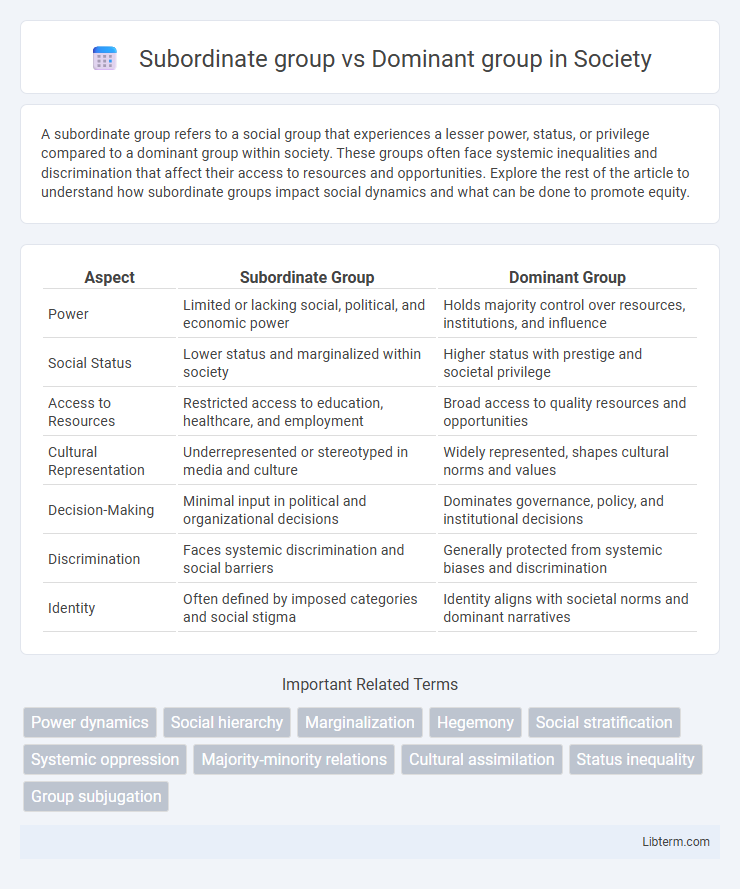A subordinate group refers to a social group that experiences a lesser power, status, or privilege compared to a dominant group within society. These groups often face systemic inequalities and discrimination that affect their access to resources and opportunities. Explore the rest of the article to understand how subordinate groups impact social dynamics and what can be done to promote equity.
Table of Comparison
| Aspect | Subordinate Group | Dominant Group |
|---|---|---|
| Power | Limited or lacking social, political, and economic power | Holds majority control over resources, institutions, and influence |
| Social Status | Lower status and marginalized within society | Higher status with prestige and societal privilege |
| Access to Resources | Restricted access to education, healthcare, and employment | Broad access to quality resources and opportunities |
| Cultural Representation | Underrepresented or stereotyped in media and culture | Widely represented, shapes cultural norms and values |
| Decision-Making | Minimal input in political and organizational decisions | Dominates governance, policy, and institutional decisions |
| Discrimination | Faces systemic discrimination and social barriers | Generally protected from systemic biases and discrimination |
| Identity | Often defined by imposed categories and social stigma | Identity aligns with societal norms and dominant narratives |
Understanding Subordinate and Dominant Groups
Subordinate groups, often characterized by limited access to power, resources, and opportunities, experience social disadvantage due to systemic inequalities imposed by dominant groups. Dominant groups hold social, economic, and political influence, shaping societal norms and policies to maintain their privileged status. Understanding the dynamics between subordinate and dominant groups is essential for addressing issues of discrimination, social justice, and equity in diverse societies.
Definitions: Subordinate Group vs Dominant Group
A subordinate group is a social category that experiences systemic disadvantages, limited access to resources, and lower status within a society due to factors such as race, ethnicity, gender, or economic status. A dominant group holds disproportionate power, privilege, and control over social, political, and economic institutions, enabling it to maintain its superior status and influence. The relationship between subordinate and dominant groups is characterized by inequality, discrimination, and social hierarchy.
Historical Contexts of Group Dynamics
Subordinate groups have historically experienced systemic disadvantages and exclusion in social, economic, and political realms, often due to colonization, slavery, or discriminatory policies enforced by dominant groups. Dominant groups maintained power through institutional control, cultural norms, and legislation that reinforced inequalities and justified social hierarchies. These historical contexts shaped group dynamics by embedding unequal access to resources, rights, and representation, which continue to influence contemporary social structures.
Characteristics of Dominant Groups
Dominant groups possess greater power, privileges, and access to resources compared to subordinate groups, often influencing social norms and institutional policies. They maintain social status through control of economic assets, political authority, and cultural dominance, enabling systemic advantages. These characteristics reinforce their position by shaping social structures that perpetuate inequality and limit subordinate group opportunities.
Characteristics of Subordinate Groups
Subordinate groups often experience limited access to power, resources, and social privileges compared to dominant groups, resulting in systemic disadvantages. These groups may face discrimination, social stigmatization, and institutional barriers that hinder equal participation in economic, political, and cultural spheres. Characteristics of subordinate groups include being subject to unequal treatment, possessing distinct cultural identities, and often developing solidarity and resilience in response to marginalization.
Power Structures and Social Hierarchies
Subordinate groups occupy lower positions within power structures and social hierarchies, often facing systemic disadvantages in access to resources, political influence, and social mobility. Dominant groups control key institutions and decision-making processes, enforcing norms and policies that maintain their privileged status and perpetuate inequality. These dynamics result in entrenched social stratification where subordinate groups experience marginalization and limited opportunities for upward mobility.
Mechanisms of Oppression and Privilege
Subordinate groups face systematic disadvantages through mechanisms of oppression such as discrimination, exclusion, and unequal access to resources, which reinforce their marginalized status. Dominant groups maintain privilege by controlling social, economic, and political power, enabling them to shape norms and institutions that perpetuate inequality. These mechanisms operate through institutional policies, cultural narratives, and everyday interactions, creating persistent disparities between subordinate and dominant groups.
Cultural Representation and Stereotyping
Subordinate groups often face limited and distorted cultural representation in media, reinforcing negative stereotypes and perpetuating social biases. Dominant groups typically control the narratives, resulting in portrayals that prioritize their own cultural norms and marginalize minority experiences. These dynamics contribute to the systemic invisibility and misrepresentation of subordinate groups, impacting their social identity and acceptance.
Resistance and Social Change
Subordinate groups employ various forms of resistance, such as protests, civil disobedience, and cultural expression, to challenge the domination imposed by dominant groups and advocate for social change. These efforts can lead to shifts in power dynamics, policy reforms, and increased social awareness, ultimately transforming societal structures. Resistance from subordinate groups is often met with opposition but plays a critical role in advancing equality and altering the status quo within dominant-subordinate group relations.
Fostering Inclusivity and Equity
Fostering inclusivity and equity requires recognizing the power dynamics between subordinate groups--those marginalized or oppressed--and dominant groups who hold systemic privilege and influence. Implementing equitable practices involves amplifying subordinate group voices through policy changes, representation, and resource allocation that address historical and structural inequalities. Creating inclusive environments demands ongoing education, active allyship, and institutional commitment to dismantling barriers that perpetuate discrimination and exclusion.
Subordinate group Infographic

 libterm.com
libterm.com